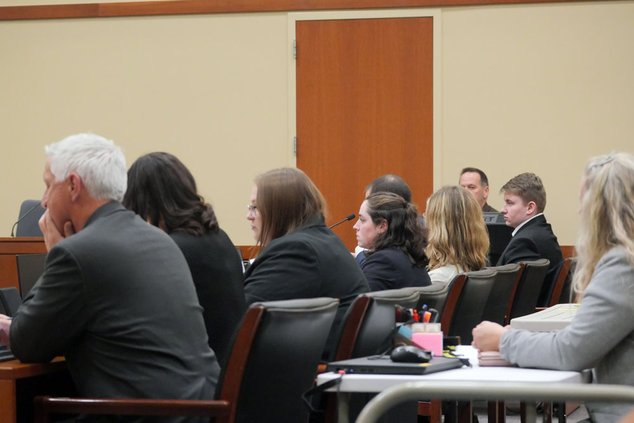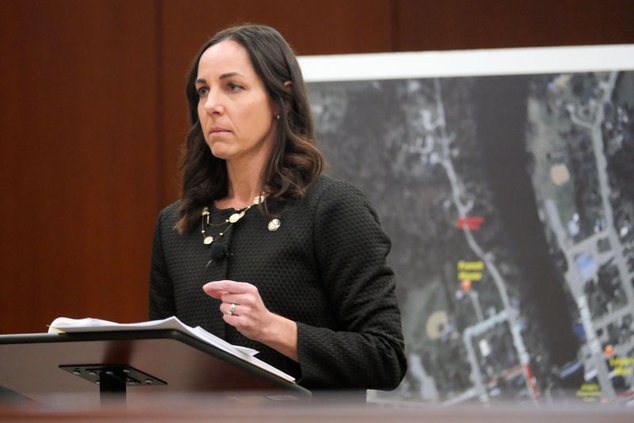Editor’s notes:
— The name of the teenage mother is being withheld by the Times out of respect that she was just 14 at the time the tragedy unfolded.
— While many of the descriptive details told to the jury have been left out, graphic details still exist. Reader discretion is advised.
MONROE — After nearly five years, there is some justice for baby Harper, the newborn murdered in cold blood in January 2021 just outside of Albany.
On Wednesday, November 5, the newborn’s father and alleged killer, Logan Kruckenberg-Anderson sat straight-faced as the jury’s verdict was read aloud by Circuit Court Judge Jane Bucher: Guilty.
Now 21, Kruckenberg-Anderson, just 16 at the time of the murder, was tried as an adult on charges of first-degree intentional homicide and move, hide or bury the corpse of a child, both felony charges. He faces life in prison. His sentencing date is tentatively scheduled for March 15.
The verdict put a close to an eight-day trial at the Green County Justice Center. The first day alone was spent sifting through about 100 potential jurors.
Throughout the trial, the prosecution presented the jury with more than 100 pieces of evidences, including explosive text messages showing possible premeditation by Kruckenberg-Anderson. The jury also heard heart wrenching witness testimony from the 14-year-old mother of his child, those that knew the young parents, and thorough testimony from the experts tasked with handling the state’s investigation.
During closing arguments Wednesday morning, Day 8 of the trial, Adrienne Blais, Assistant Attorney General at Wisconsin Department of Justice spoke directly to the jury, reiterating the damning evidence.
“This is a heinous crime that has haunting details. It’s one person fantasizing about playing house, and one person bent on erasing a problem, because that’s what Harper was to him — a problem to screw up his life, so he got rid of her. He tried to make her go away,” Blais said. She also read aloud a message the defendant had sent to his girlfriend weeks before baby Harper was born. “Baby, I wanna know before your mom does. Either someone takes it, or it takes a slug.”
Blais lamented the fact that none of Kruckenberg-Anderson’s messages in the months leading up to the birth discussed the possible gender, a name or other topics expecting parents tend to have. He spent the entire December before telling his pregnant girlfriend to get an abortion
“Instead there were jokes about metal coat hangers and abortion, and lists of all the ways it will ruin his life. He chose time and time again to speak negatively about the pregnancy,” Blais continued.
“Surely he was just trying to be tough, because he wouldn’t do that to a baby,” Blais said in jest of the premeditated murder messages. “Chubby face, curly brown hair, blue-eyed baby girl. Who would say such ugly things? The person that would lay a newborn, naked baby girl in the snow — no swaddle, no onesie, no blankie — would stand back and shoot. Twice.
“He thought he was a young man who could just erase a baby’s existence. He didn’t want something to [mess] his life up and then could manipulate his way to get out of wrong doing.”
The defense attempted pivot on the topic of readying for a newborn child. The young mother testified that she wanted to keep the baby, but defense attorney Kevin Smith questioned why she hadn’t purchased materials ahead of time: diapers, blankets, bottles, clothes, and breast feeding pumps, among other items. In rebuttal, Blais reminded the jury this was a 14-year-old girl with no job, no money, no car and was hiding the pregnancy from her parents.
“There’s a reason why we don’t allow 14-year-olds to drink, or drive, or vote — because 14-year-olds are bad at planning ahead,” Blais said.


In fact, nearly all of Kruckenberg-Anderson’s lawyer’s entire defense was blaming the young mom — just an eighth-grader at the time.
“Combative. Evasive. Shifted blame — her mother for not being attentive, the doctor for not recognizing she was pregnant,” Smith said of the young woman who was just one of two people to see or hold Harper before her murder. “She is not dumb. She’s a smart kid. She navigated labor by herself. It’s not as if she didn’t know the right thing to do. It’s not that she didn’t know these things were wrong. She knew.”
Smith suggested Kruckenberg-Anderson was simply taking the fall for the girl that he loved. He alleged the possibility that the young mother may have been the actual killer.
Blais said it is out of the realm of possibility that a 14-year-old girl pulled a fast one and duped all of the State of Wisconsin forensic experts, special agents and investigators, pinning the crime on her boyfriend.
“She somehow setup a conspiracy that Logan was set up, as if some kind of a mastermind that confused law enforcement and throw them all off track? That’s not reasonable in the least,” Blais said. “And if she wanted to frame Logan to take the fall, all she had to do was say, ‘he did it, he told me he did it.’ But she never said that one time.”
Instead, the guilt of the murder points directly to Kruckenberg-Anderson, given his confession, the incriminating text messages, DNA and ballistics evidence.
“She is one of only two people to have seen her alive. She is one of only two people to hold her” Blais said. “Let me be clear, you don’t have to like [the mother]. You don’t have to condone anything she did. This trial is not a referendum on [the mother]. She made objectively terrible choices, choices she feels shame and regret over. The fact that another person may have been involved does not take away that this trial is about Logan Kruckenberg-Anderson,” Blais reiterated.
During his 90-minute closing argument, Smith also attempted to use some theatrical tactics. He ran a power point presentation, trying to show that two lying teenagers left more questions than answers in the “horrific tragedy.” At one point, he showed the jury the opening lines of the U.S. Constitution, “We the people”, and tried to equate a modicum of doubt the jury might have to being “reasonable doubt” the jury would need to convict.
According to the United States Courts for the Ninth Circuit in 2021, “Proof beyond a reasonable doubt is proof that leaves you firmly convinced the defendant is guilty. It is not required that the government prove guilt beyond all possible doubt. A reasonable doubt is a doubt based upon reason and common sense and is not based purely on speculation. It may arise from a careful and impartial consideration of all the evidence, or from lack of evidence.”
Smith alleged that Kruckenberg-Anderson wasn’t in good enough shape to walk less than a mile and a half in 32 minutes — the elapsed time a downtown bar’s security camera shows the alleged killer crossing the Main Street Bridge and returning during lunchtime on January 5, just hours after Harper was home.


Smith even brought up his client’s confession tape, which had been clipped and played to the jury. He said they had only watched about 10 minutes of the two hour interview, a manipulation tactic by the state, and that his client was pushed into confessing to fit the investigators and state’s narrative. Blais rebutted that the defense had the same video evidence and could have shown any contradictory footage, but didn’t — because it didn’t exist.
“Those confessions of his, his own statements, his own words — the details that he gave was corroborated by other evidence. The details he gave coincides with digital, spoken, physical evidence,” Blais said. “His lies are provable lies, and his truths are provable truths. The fact is, the defendant provided details that only the killer would know.”
Kruckenberg Anderson’s recorded interview with law enforcement includes him telling why he shot the baby in the head and not the heart — because he didn’t know if he would be able to hit the heart. The two bullets were found in the earth, dug up from the scene and sifted through by forensics investigators. He described to investigators the gun he used, the writing on the gun, how many times he shot it. He described his path to the scene and back.
When investigators asked how he knew he hit Harper with the bullets, Kruckenberg-Anderson said he saw the black marks in the baby’s forehead, consistent with what the autopsy discovered. He said he then stepped over the baby and a log next to her to leave, but also dropped down and cried about shooting the child. He also told investigators he planned to go back in the spring and bury the body.
“These were details he provided,” Blais reiterated. “These were not detail fed to him. He said that. ‘I covered her in snow, then I turned around to walk away, and I dropped down and cried.’”
Before sending the jury to deliberate and come up with a verdict, Blaide finished her rebuttal by rebuking the defense one last time.
“They said to take out their snapchat messages and the confession. ... If you get rid of all the evidence, you can speculate all you want” she briefly quipped, before getting serious again.
“Harper wasn’t able to be here today, but you heard her voice through the witnesses,” Blais continued. “Now, ladies and gentlemen, Harper’s voice speaks through you and your verdict.”
About two hours later, the jury came back with the guilty verdicts. Kruckenberg-Anderson was mostly emotionless. The mother, now a legal adult, was sitting on the far side of the room with two of her best friends. She cried at the finale of the nearly five-year long emotional ordeal.


